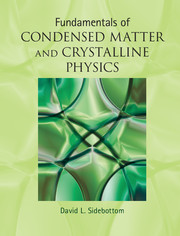 Fundamentals of Condensed Matter and Crystalline Physics
Fundamentals of Condensed Matter and Crystalline Physics Part IV - Transitions
Published online by Cambridge University Press: 05 August 2012
Summary
TRANSITIONS
On my bulletin board I have a picture of a recent U.S. president that someone has photo shopped to include a text balloon that says, “The ice caps are not melting. The water is being liberated.” Although intended to be humorous, there is an element of truth to this statement. Phase transitions are in many respects the result of a competition or war between two opposing forces. On one side are the attractive interactions between particles that act to bind them together and force them into a more ordered structure – a world governed by potential energy. On the other side is thermal energy that acts to break these bonds and liberate the particles so that they are free to move about – a world dominated by kinetic energy. There is then a point of transition where one world order trumps the other and it is this phenomenon that we consider in this final set of chapters.
There are many sorts of phase transitions, but the two prominent examples we will consider are the gas-to-liquid transition and the transition of paramagnet-to-ferromagnet. In spite of the obvious differences between these two systems, we will emphasize a remarkable level of similarity in how their phase transitions proceed and how order develops in both situations.
Beginning in Chapter 15, we lay some groundwork regarding the fundamental nature of phase transitions and explore the meanings behind various phase diagrams used to describe the transitions between different phases. Here we examine the competition between inter-particle interactions and thermodynamic forces in determining the conditions for phase transitions to occur and emphasize the special role played by thermodynamic fluctuations near socalled “critical” points, where certain thermodynamic quantities tend to diverge.
- Type
- Chapter
- Information
- Fundamentals of Condensed Matter and Crystalline PhysicsAn Introduction for Students of Physics and Materials Science, pp. 265 - 266Publisher: Cambridge University PressPrint publication year: 2012


